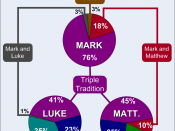The gospels, which seem more of a proclamation to be preached than a biography of Jesus, reflect the historical nucleus of Jesus' life. All three synoptic gospels transmit the same central content, reflecting on Jesus' teachings and his status as the Messiah announced in the Old Covenant. However, they differ because of dissimilar view points and focus, different audiences, and different circumstances under which they were written. Some of the variations between the synoptic gospels can be easily identified by comparing any particular event narrated in all three gospels. In "Plucking Heads of Grain on the Sabbath" (Mat 12: 1-8, Mar 2: 23-28, Luk 6: 1-5) the argument and wording is almost identical in the three gospels, and still differences can be readily noted on style and structure.
In most of Mark's gospel, redundancy and some syntax awkwardness can be found. For example, the author writes in his story about the man and the Sabbath: "...his
companions were hungry and in need of food..." An oral style can also be detected from the very first verse of the passage and remains throughout the chapter: "One Sabbath he was going through the grain fields; and as they made their way his disciples began to pluck heads of grain." These verses prove that Mark is written in a colloquial manner. The creator is not interested in discourses or eloquence but specifically in preaching the acts of Jesus in a conventional way to the average Roman. He is the only one of the three to outline precisely what the story aims to impart: "The Sabbath was made for humankind and not humankind for the Sabbath."
On the contrary, Luke's author wrote in a more elevated literary style. Luke takes Mark's writings about the Sabbath just about word by word but pares it...


